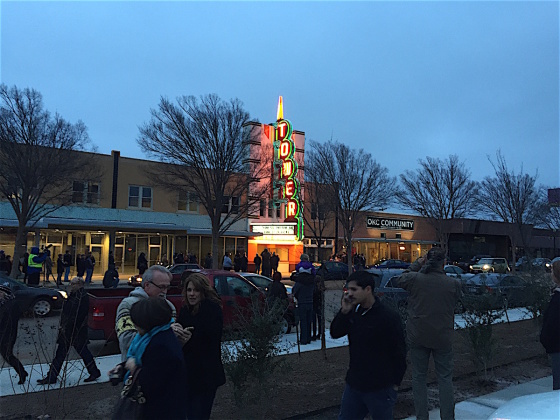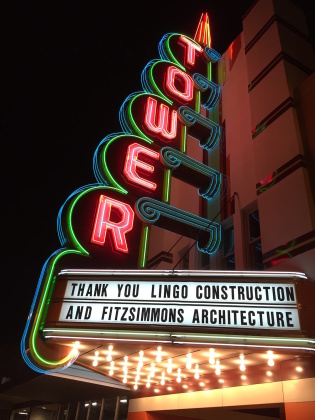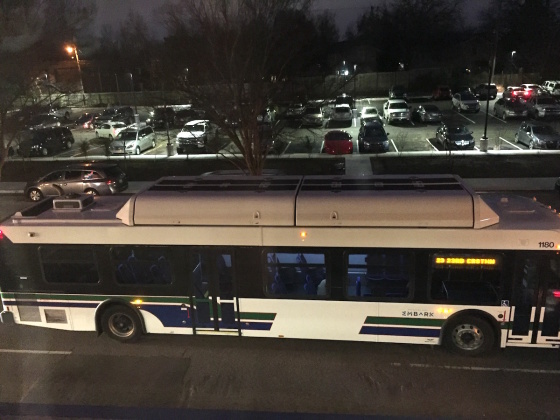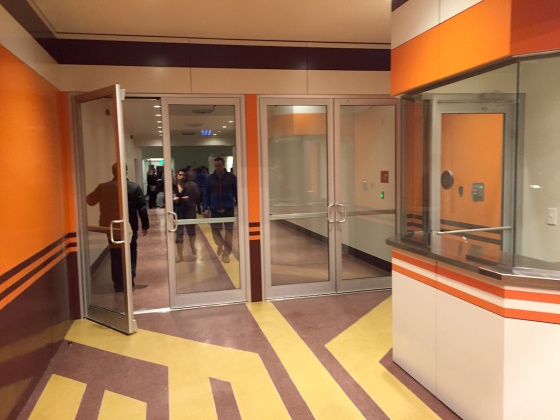
The sidewalks around 425 N.W. 23rd Street were all abuzz Friday evening. In the midst of rush-hour traffic, pockets of people milled about as two drones hovered overhead.
It was all in anticipation of the Tower Theater firing up its neon sign in preparation of reopening for the first time since it closed in 1989. Once lit, the developers stood in the new parking lot across 23rd Street and thanked those gathered for Oklahoma City’s support of the project. They offered an update on progress and an explanation of the building’s scope before inviting the public to tour it.
Local developers David Wanzer, Ben Sellers and Jonathan Dodson have worked since 2014 to renovate the building into a commercial property that combines a ground-floor concert and film venue with an upstairs bar and office space concept. Another bar will be along the ground level.
“We’re still working on a restaurant tenant,” Wanzer told the crowd. “We’re excited to bring it back to life.”
The Tower Theater’s trademark sign had actually been featured in a lighting ceremony as recently as 2011, after crews worked for four months to painstakingly restore the sign with the aid of grant money from the Route 66 Preservations Program.
A ‘fabulous’ venue
The architecture of the building allows for a concert venue to occupy most of the ground floor, but almost 8,000 square feet of retail will face N.W. 23rd Street. Meanwhile, about 4,500 square feet will be devoted to second-floor office space. Overall, the Tower offers just more than 31,000 square feet.
“It means a tremendous amount to 23rd Street. The last time I was in here, I was walking through pigeon droppings and things,” said OKC Ward 6 Councilwoman Meg Salyer. “What’s in my head right now is Pharrell Williams’s ‘Happy.’ For some odd reason, I just heard it, and it makes you feel like that. It makes you want to dance. It feels like a room without a ceiling in here, it’s so tall.”
The building (actually two joined buildings) is big, and big investments can mean big risks when Oklahoma’s economy is slumping from low oil and gas prices.
But Salyer said she believes making investments “when times are tough” simply positions businesses and cities more favorably when strong economic times return.
“In this particular moment, lots of folks are benefiting from the low price of gasoline,” she said. “If folks have a little bit more money in their pockets, they tend to be using it to go to entertainment venues, and this promises to be a fabulous one.”
The Tower Theater: OKC’s answer to Cain’s
Scott Marsh’s Levelland Productions will be in charge of the venue’s operations, including its booking.
“Fingers crossed, we open in April,” he said.
Marsh believes the addition of the Tower Theater as a concert destination for nationally touring acts will benefit the local music scene.
“We get skipped over all the time,” he said. “For Tulsa, anybody coming from Kansas City, to Dallas down to Austin, they skip over Oklahoma City because there’s not a venue of this size, of this calibre that kind of brings in the types of acts that Oklahoma City’s wanted for years.”
For lovers of live music, Cain’s Ballroom in Tulsa remains the state’s premier venue with regard to the size, consistency and frequency of their headlining acts. Cain’s boasts capacity of 1,700, and, although the Bricktown Events Center has a capacity of 1,800, Marsh said he hopes the Tower Theater — even at a projected standing-room capacity of about 1,000 — can attract the kind of acts that book at Cain’s.
“I think it really lends itself toward being the theater that Oklahoma City has always deserved and that a lot of other cities already have,” Marsh said. “We’re a full on city, and I think a theater of this magnitude speaks volumes to that.”
William W. Savage III contributed to this report.
(Correction: This story has been updated to refer to Jonathan Dodson’s role with the development group accurately. Bank SNB and Bank of Oklahoma have provided financing for the project.)






































